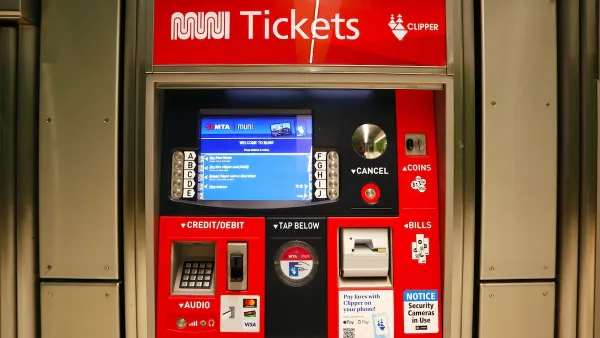Low-income transit users desperately need a break on fares. A discount is on its way, but won’t be available until later in the year, and transit advocates say it’s not enough.

Rachel Swan reports on the San Francisco Bay Area plan to provide a fare discount of 20 percent to low-income riders using BART, Caltrain, Muni, and Golden Gate ferries and buses. Implementation has been slow as the discount was approved last May but may not start until November.
Critics say the discount should be higher to address the economic hardships that low-income transit users are facing in the Bay Area, notes Swan:
Housing tends to be cheaper far away from job centers, which raises the price of commuting. For many people, it means more transfers, more complexity and more fares tacked on. And BART’s fare system, unlike that of some other metro rail lines, charges more for longer trips.
Advocates also say that other groups are already getting discounts — such as seniors and young people — and low-income riders should similarly get help in an area with an astronomical cost of living.
Transportation officials acknowledge that the cost of transit is a burden and the discount is just one step in the right direction. But they are concerned about how the agencies will cover their portions of the $20.7 million annual cost of the program without cutting back on services.
FULL STORY: Bay Area’s low-income transit riders, after long wait, to receive discounts

Planetizen Federal Action Tracker
A weekly monitor of how Trump’s orders and actions are impacting planners and planning in America.

Chicago’s Ghost Rails
Just beneath the surface of the modern city lie the remnants of its expansive early 20th-century streetcar system.

San Antonio and Austin are Fusing Into one Massive Megaregion
The region spanning the two central Texas cities is growing fast, posing challenges for local infrastructure and water supplies.

Since Zion's Shuttles Went Electric “The Smog is Gone”
Visitors to Zion National Park can enjoy the canyon via the nation’s first fully electric park shuttle system.

Trump Distributing DOT Safety Funds at 1/10 Rate of Biden
Funds for Safe Streets and other transportation safety and equity programs are being held up by administrative reviews and conflicts with the Trump administration’s priorities.

German Cities Subsidize Taxis for Women Amid Wave of Violence
Free or low-cost taxi rides can help women navigate cities more safely, but critics say the programs don't address the root causes of violence against women.
Urban Design for Planners 1: Software Tools
This six-course series explores essential urban design concepts using open source software and equips planners with the tools they need to participate fully in the urban design process.
Planning for Universal Design
Learn the tools for implementing Universal Design in planning regulations.
planning NEXT
Appalachian Highlands Housing Partners
Mpact (founded as Rail~Volution)
City of Camden Redevelopment Agency
City of Astoria
City of Portland
City of Laramie





























